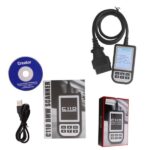While all light-duty vehicles manufactured since 1997 are equipped with a standard 16-pin OBDII port, the situation is different for heavy-duty vehicles like fire engines. Whether a diesel fire engine has an OBD2 port depends largely on its year of manufacture and the specific engine manufacturer.
OBD2 Ports in Heavy-Duty Vehicles
Heavy-duty trucks, including some fire engines, haven’t always adhered to the same OBDII standardization as passenger vehicles. Prior to 2010, many heavy-duty diesel engines utilized proprietary diagnostic connectors. However, with the implementation of stricter emissions regulations, more modern diesel fire engines are likely to feature an OBDII port.
Variations in Diagnostic Ports
Even when an OBDII port is present on a diesel fire engine, it might not function identically to a light-duty vehicle’s port. Data availability and communication protocols can vary significantly. Furthermore, some fire engines may utilize other diagnostic connections alongside or in place of an OBDII port, such as:
- 9-Pin Deutsch connectors: Commonly found in heavy-duty trucks and off-road equipment, particularly older models.
- 6-Pin Deutsch connectors: Also prevalent in older heavy-duty vehicles.
- 14-Pin J1939 connectors: A standard for heavy-duty vehicle communication, often used for engine and transmission data.
- Proprietary connectors: Specific to certain engine manufacturers, requiring specialized adapters for diagnostics.
 Comparison of different diagnostic ports.
Comparison of different diagnostic ports.
Locating the Diagnostic Port
The diagnostic port on a fire engine is typically located under the dashboard on the driver’s side, similar to most vehicles. However, its exact position can differ based on the manufacturer and model. Consulting the vehicle’s manual or contacting the manufacturer can provide definitive information.
Diagnostic Adapters and Software
Due to the potential variations in diagnostic ports, using the correct adapter and software is crucial. Generic OBDII scanners might not be compatible with all heavy-duty diesel engines. Specialized heavy-duty diagnostic tools are often necessary to access comprehensive engine data.
Fire Engine Manufacturers and OBD2
Fire engine manufacturers often utilize chassis and engines from various heavy-duty truck manufacturers. This can further complicate the presence and functionality of OBDII ports. For instance, fire engines built on a Freightliner chassis might have different diagnostic connections compared to those built on a Spartan chassis.
.pdf)
Conclusion
Determining whether a specific diesel fire engine has a functional OBD2 port often requires checking the vehicle’s documentation or conducting a physical inspection. The year of manufacture, chassis manufacturer, and engine manufacturer all play a role in the type of diagnostic connection available. If in doubt, contacting the fire engine manufacturer or a qualified heavy-duty vehicle technician is recommended. While newer models are more likely to be equipped with a standard OBDII port, older fire engines may require specialized diagnostic equipment.
